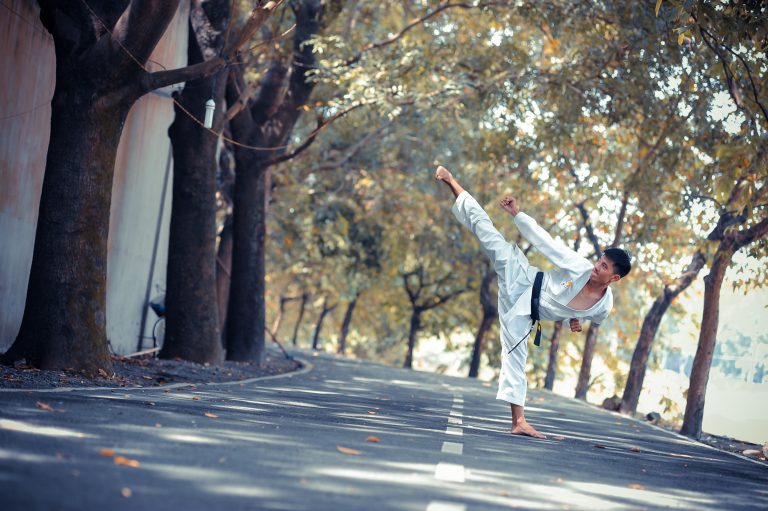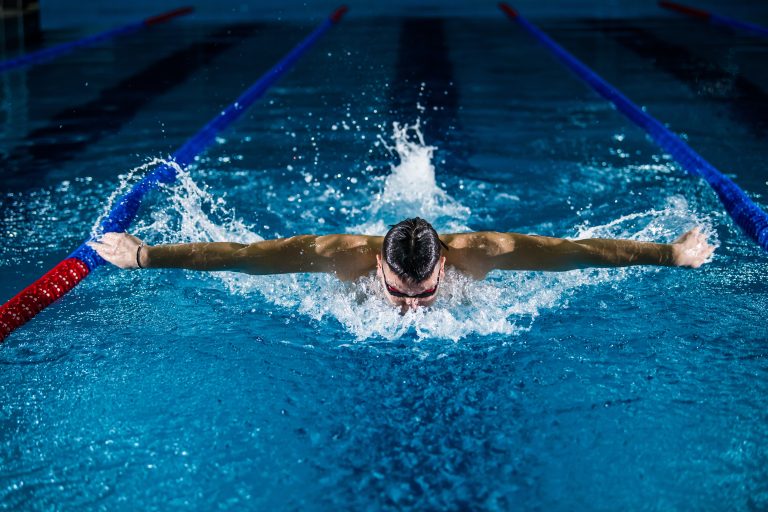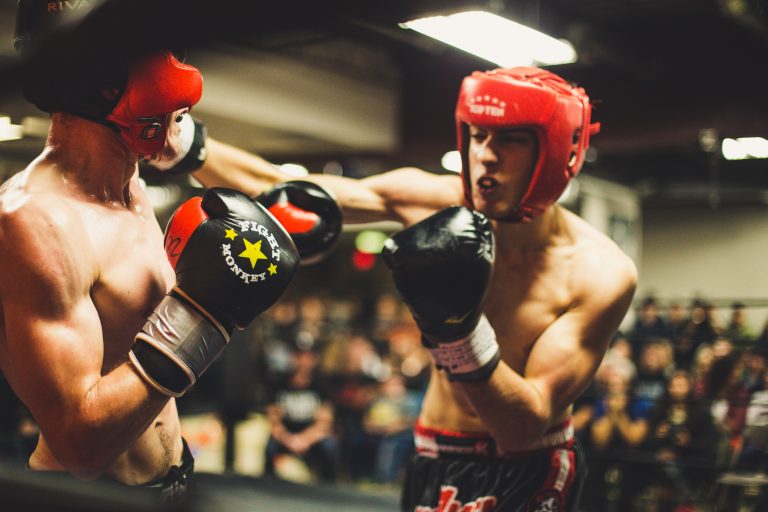What is Karate and How to Get Started in Karate?
The word ‘karate’ means ‘empty hand’ in Japanese – highlighting how this martial art is focused on defending oneself without weapons. The practice of karate began in Okinawa, Japan but has since become popular in western countries. It combines self-defense techniques to develop physical strength, character, and focus.
Karate can look intimidating, but all ages and ability levels can enjoy and succeed in Karate with some dedication. In this guide, we will cover the basics of karate, the benefits of practicing it, the different karate styles and how to find a class and get started in karate.
What is Karate?
Karate is a martial art that originated in Okinawa, Japan. It is fundamentally composed of unarmed combat techniques that can be used for self-defense and competition. Karate techniques involve punching, kicking, arm strikes, knee strikes, elbow strikes, and open-hand techniques such as joint locks, as well as throws and vital point strikes.
The Benefits of Practicing Karate
Practicing karate can provide a lot of physical and mental benefits. Physically speaking, it improves strength, flexibility and coordination, while it also helps with weight loss and cardiovascular conditioning. On the mental side of things, karate boosts confidence and discipline while teaching problem-solving and focus. Practicing karate also helps with managing stress as well as improving self-defense and reflexes.
Different Types of Karate
Most karate styles have similar elements at their core – although there are some variances between them. Some of the most popular types of karate include:
- Shorinji-ryu: A traditional Okinawan karate style emphasizing strong stances, blocks, kicks and strikes.
- Shotokan: Developed in Japan in the early 20th century, this style is focused on linear movements and strong stances.
- Goju-ryu: Characterized by its linear movements and use of breathing techniques.
- Wado-ryu: Combining elements of judo and Shinto-ryu, this style is focused on evasion and blocking.
- Kyokushin: An intensity-driven style that emphasizes fitness and strength.
Getting Started with Karate
Karate is ideal for individuals of all age groups, fitness levels and backgrounds. First things first – make sure to find a good school that can provide you with effective instruction. Here’s how to begin your journey into karate:
Step 1: Find an Appropriate Class
The best choice in this regard is one that suits your interests, skill level and budget. Remember that while most classes are suitable for beginners, there are some designed specifically for more advanced students. Ask around or search online to find a reputable instructor or school near you.
It is also important to consider the class size. Smaller groups are better for beginners since you will receive more individual attention from the instructor. Larger classes can be good for experienced students who need less individual guidance about techniques.
Most schools will offer a free trial class so you can observe the instructor and environment before signing up for lessons. Other important factors to consider are insurance coverage, scheduling options and location.
Step 2: Choose Your Gear
You don’t need fancy equipment when starting out in karate. Beginners should typically invest in a good pair of martial arts shoes or boots. A loose-fitting white uniform (or ‘gi’) is also necessary when practicing karate and you can find these online or at most martial arts stores. Make sure to wash your uniform after each training session to keep it free from bacteria and odors.
Other gear that may be required by your instructor include: boxing gloves, shin guards, headgear (usually used when sparring), mouth guards and protective groin gear. As you progress in karate you may also want to buy equipment such as focus mitts or a heavy bag for additional training and sparring opportunities.
Step 3: Follow Your Instructor’s Directions
No one expects a total beginner to understand all of the finer aspects of karate straight away, so it’s important to learn from scratch by following your instructor’s instructions. Don’t be afraid to ask questions – even the most experienced martial artists never stop learning! Being open minded is key to developing your skill set and practicing with partners should help you learn at a faster pace.
Step 4: Practice Often and Expand Your Knowledge
Success in martial arts requires consistent practice. Aim to practice three times a week if possible so that you can progress in your progressions effectively. Additionally participants should look at ways to expand their knowledge outside of the dojo which could include reading books related to karate or watching instructional videos online.
Conclusion
Karate is a popular martial art that has been practiced for centuries – helping individuals develop both physically and mentally while learning self-defense techniques. Whether you’re new to martial arts or have some experience, karate has something to offer everyone as long as you’re dedicated to practice and have a good instructor. Through finding an appropriate class, choosing your gear, following instructions from your instructor and practicing often, you can get started on your journey into the world of karate.
What is Karate and How to Get Started in Karate?
Karate is a martial art that originated in Japan and has now become popular worldwide as a sport, self-defense technique, and a way of life. The word ‚Karate‘ means ‚empty hand,‘ which implies that Karate does not involve any weapons, and the practitioners use their hands and feet for striking, blocking, and grappling techniques. If you are interested in learning Karate and want to know how to get started, this blog is for you. We will answer some of the most frequently asked questions about Karate and guide you on how to begin your Karate journey.
What are the benefits of learning Karate?
Karate has several benefits for both physical and mental health. Some of these benefits are:
Physical health benefits
- Improved cardiovascular health
- Increased muscle strength and endurance
- Better coordination and balance
- Increased flexibility and range of motion
- Better reflexes and reaction time
Mental health benefits
- Improved focus and concentration
- Increased self-confidence and self-esteem
- Better stress management and resilience
- Increased discipline and self-control
- Better problem-solving and decision-making skills
What are the different styles of Karate?
Karate has several different styles, each with its unique techniques, forms, and philosophies. The most popular styles of Karate are:
Shotokan
Shotokan is one of the oldest and most popular styles of Karate. It emphasizes strong, linear movements and techniques such as punches, kicks, and blocks.
Wado-Ryu
Wado-Ryu is known for its fluid and graceful techniques and focuses on using the opponent’s force against them. It incorporates elements of traditional Japanese martial arts such as jujutsu and Aikido.
Goju-Ryu
Goju-Ryu is a more traditional and conservative style of Karate. It emphasizes circular movements and techniques and includes both hard and soft styles of fighting.
What is the process to get started in Karate?
Getting started in Karate is a simple process that involves the following steps:
Step 1: Find a reputable Karate school or instructor
The first step to getting started in Karate is to find a reputable Karate school or instructor. Look for schools that have experienced instructors and a good reputation in the community. You can check online reviews or ask for recommendations from friends or family members who practice Karate.
Step 2: Attend a trial class
Most Karate schools offer trial classes that allow you to try out their programs before committing to them. Attend a trial class to get a feel for the school’s teaching style, the instructor’s approach, and the overall atmosphere.
Step 3: Purchase Karate gear
Once you have decided to join a Karate school, you will need to purchase some basic Karate gear, including:
- Karate uniform (Gi)
- Belt (Obi)
- Hand wraps
- Mouthguard
Step 4: Start training
Once you have purchased your Karate gear, you can start attending regular classes and training. Most Karate schools offer several classes per week that cater to students of different levels, ages, and abilities.
What are the different levels of Karate belts?
Karate uses a grading system that awards students different colored belts based on their rank and progress. The different levels of Karate belts, from beginner to advanced, are:
White belt (beginner)
The white belt is the starting rank for all Karate students. It represents purity and the beginning of the Karate journey.
Yellow belt (8th kyu)
The yellow belt is the first colored belt that students can earn. It represents the growth and the development of basic Karate skills.
Orange belt (7th kyu)
The orange belt represents the student’s progress and continued growth in their Karate journey.
Green belt (6th kyu)
The green belt represents the student’s increased knowledge and proficiency in Karate techniques.
Blue belt (5th kyu)
The blue belt represents the student’s deeper understanding of Karate principles and philosophy.
Purple belt (4th kyu)
The purple belt represents the student’s increased level of experience and skill in Karate.
Brown belt (3rd-1st kyu)
The brown belt is the highest-ranking belt before earning the black belt. It represents the student’s mastery and dedication to Karate.
Black belt (1st degree and above)
The black belt represents the ultimate level of achievement in Karate. It represents the student’s mastery of Karate techniques, principles, and philosophy.
Conclusion
Karate is an excellent martial art that offers several physical and mental health benefits. Getting started in Karate is a simple process that involves finding a reputable school, attending a trial class, purchasing gear, and starting training. The different styles of Karate offer unique techniques and philosophies, and the different levels of Karate belts allow students to track their progress and growth in the art. Whether you are interested in Karate for self-defense, fitness, or personal growth, the benefits of learning Karate are endless.
Inhaltsverzeichnis






